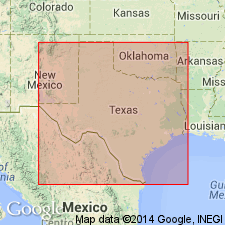
- Usage in publication:
-
- Buffalo Hill sandstones
- Modifications:
-
- Original reference
- Dominant lithology:
-
- Sandstone
- AAPG geologic province:
-
- Permian basin
Summary:
Sec. opp. p. 96 (pl.). Buffalo Hill sandstones of Clear Fork group. Consist of two thick sandstones separated by shale, and lie 80+/- feet above base of Tye formation (basal member of Clear Fork beds in Taylor and Runnels Counties, Texas). [Age is Permian.]
[Origin of name not stated. Present in section measured along Texas and Pacific RR from Abilene, Taylor Co., to Sweetwater, Nolan Co., central northern TX.]
Source: US geologic names lexicon (USGS Bull. 896, p. 288).

- Usage in publication:
-
- Buffalo Hill sandstone
- Modifications:
-
- Revised
- AAPG geologic province:
-
- Bend arch
- Permian basin
Summary:
Pg. 169. Buffalo Hill sandstone is here included in Vale formation. It lies near base of Clear Fork group. Age is Permian.
Named from Buffalo Hills, Taylor Co., central TX.
Source: US geologic names lexicon (USGS Bull. 896, p. 288).
For more information, please contact Nancy Stamm, Geologic Names Committee Secretary.
Asterisk (*) indicates published by U.S. Geological Survey authors.
"No current usage" (†) implies that a name has been abandoned or has fallen into disuse. Former usage and, if known, replacement name given in parentheses ( ).
Slash (/) indicates name conflicts with nomenclatural guidelines (CSN, 1933; ACSN, 1961, 1970; NACSN, 1983, 2005, 2021). May be explained within brackets ([ ]).

